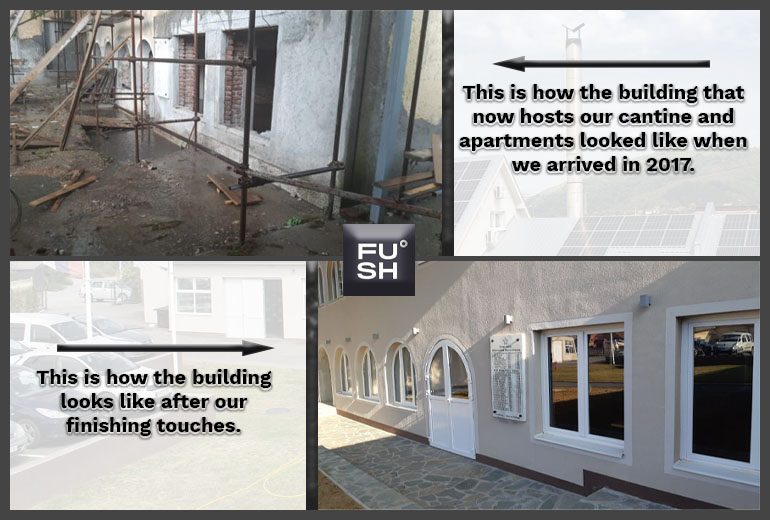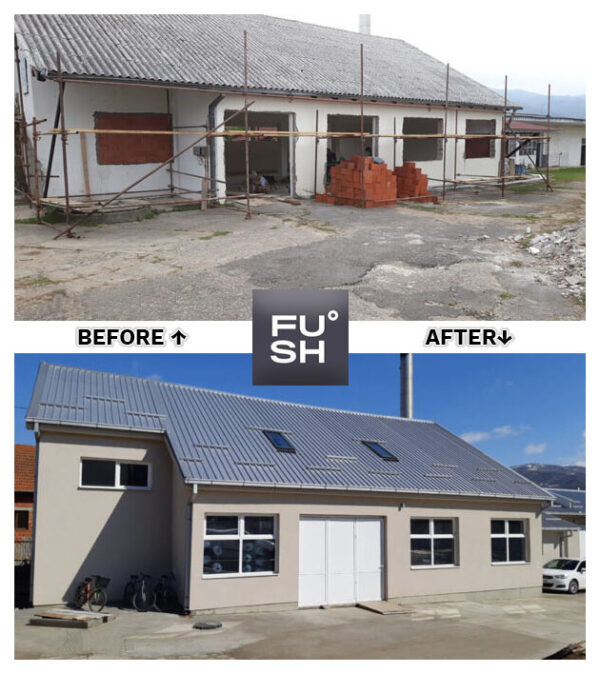This is the second part of the Sustainable Expansion of FUSH˚ clothing factories series. Here, we will talk about our big expansion to a facility spanning over 2000 square meters.
The original factory ITP Gredlica started working on 22nd February 1958 near the small village of Oraovica in the southeastern part of Serbia. During its golden days that lasted through a couple of decades, the factory made impressive numbers of knitwear and yarn and employed around 600 workers.
Unfortunately for the people of the Jablanica district, especially from Oraovica, the factory stopped working in the late 90s and finally went bankrupt in 2011.
It had a short spell of rejuvenation from 2012-2014 when textile production briefly resumed but failed due to an unfortunate turn of events.
Our involvement with the former ITP Grdelica facilities started in 2017.
Ok, that was the ultra-brief history of what is now a FUSH˚ textiles factory. Now let us tell you a story of just how much we had to do to get the factory into the 21st century.
FUSH˚ – turning former ITP Grdelica into a modern clothing factory
As we said, after the initial brief inspection in 2017, we bid for the factory and officially acquired it. The aim was to stop outsourcing the following services – fabric manufacturing and sewing. The ITP Grdelica project was supposed to handle both services.
The challenges for achieving that kept piling up as we got more involved. One problem that comes with the literal territory of the factory is the fact that Oraovica is a remotely-located village and, as such, is often hit with water and electricity shortages. That is something that was accounted for.
But a lot wasn’t.
Some of such issues were due to buildings not adhering to the current standards required by Serbian laws. Also, some of it had to do with the 20-year-long neglect of an already inefficiently-built factory.

Here you can see the gravity of the situation we faced and just how much we fixed things around the facility
Obstacles, obstacles, obstacles
Here’s a list of all the issues we faced:
- No modern sewage system at the facility (relying on the existing cesspool was not an option).
- Unfit drainage channels (which flooded during heavy or frequent rains).
- Lack of watershed management solutions.
- Irregularly-laid foundations that either had no framework or had an unfitting framework.
- Damaged roofs and supporting constructions and humidity-ridden objects, caused by decades-long exposure to the elements and abandonment issues (yes, buildings get depressed too when they’re lonely).
- Unfit electrical wiring (household wires and three-phase current sensing relays instead of their industrial counterparts).
- Buildings with critically low energy efficiency, even when you take their worn-down nature out of the equation.
- Damaged and/or cracked heating piping
- Lack of industry-specific lighting.
And what we did was, for the most part, start from scratch. That means we’ve:
- 1. Installed new electric wiring.
- 2. Modernized the electric switch boxes.
- 3. Changed the heating piping.
- 4. Installed the first plumbing piping ever in all the buildings.
- 5. Installed proper sewage piping and a wastewater treatment plant.
- 6. We’ve dug wells for technical and drinking water so that the frequent water shortages in Oraovica can’t affect us.
Those were essential.
Next, we had to make the facilities on the factory grounds energy efficient. In some cases that meant taking down the entire building and constructing a new one. In some cases, it meant thermally insulating the old ones and changing windows and doors on them.

The following big problem was flooding. Imagine the state of an unprofessionally-built facility from the 50s, abandoned in the 90s. If your guess was rubble-like, you were right. Add to that that not every building had foundations, so some of them had a higher susceptibility to letting in water.
Enter excavators, enter concrete. We’ve dug through the entire facility and poured a lot of concrete to eliminate the flooding issue, which we did. With all the facilities tightened up, we could finally start putting machinery in the building:
- • Circular knitting machines
- • Sewing machines
- • Dye sublimation printers
- • Dye sublimation calenders
- • Industrial ironing presses
- • Folding machine
Sustainability at the Oraovica clothing factory
As Oraovica has no link to the municipal sewage system, the most common way of treating wastewater was simply chucking it into the nearby river. That was not at all what we planned to do. We’ve installed the RotoClear 40 PE wastewater treatment plant to solve this issue. It’s capable of handling wastewater from our factory working at 100% capacity. It even has accreditation from the PIA.

RotoClear 40 wastewater treatment system during installation at the factory grounds in Oraovica.
To ensure we’re making the wastewater as safe as possible for the environment, we’re using a mixture of good bacteria developed by the Serbian company Bistrol. It fully decomposes any organic waste, making the water leaving our factory 100% eco-friendly.

People of FUSH˚
Since people are and should be a part of any company’s sustainability efforts, let’s learn more about the people of FUSH˚ from Oraovica and their working conditions. It’s great that most of them are people from the industry. That’s no surprise, being that the textile trade was strong in this region and hopefully will be again.

Our sewing department during the pandemic. They work at a reduced capacity to maintain safe working conditions.
We’ve managed to employ 100 textile professionals so far. The lowest wage at the factory is 20% higher than the national minimum wage.
The factory holds an ISO certificate for worker safety (ISO 45001:2018). Also, being that there’s no public transport in rural Serbia, our workers have the option to use the company’s bicycles.
The future of our Oraovica clothing factory (2022 update)
The factory can rely 100% on solar for all its electricity needs for two-thirds of the year. During overcast periods, solar panels provide anywhere between 35% and 65% of the electricity needed for all departments to work at maximum capacity.
We’ve finished all the apartments in the factory complex so you can pay us a visit and stay the night right where the magic of clothing manufacturing happens. Take a virtual tour to check out one of the rooms.
Request a quote from us
To get the best possible price and lead time estimate, please include the number of designs and pieces per design, fabric choice, sizes, and printing options.
- FUSH˚ Addresses:
- Velizara Stankovića 67
Belgrade, Serbia (view in Google Maps) - Oraovačka BB
Oraovica, Serbia (view in Google Maps)
- Velizara Stankovića 67
- Phone: +381 11 359 10 48
- Email: info@fush.rs